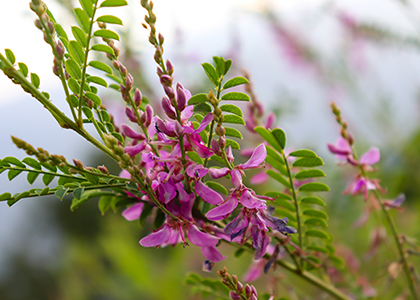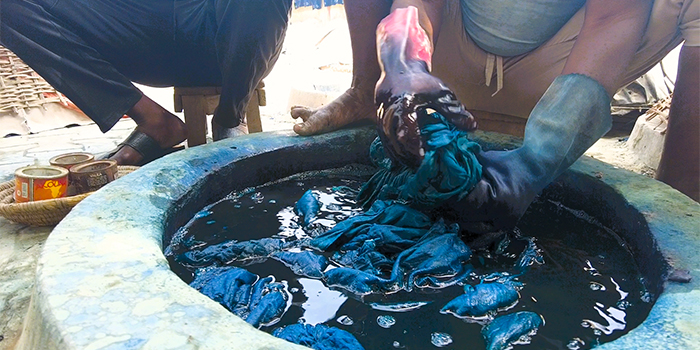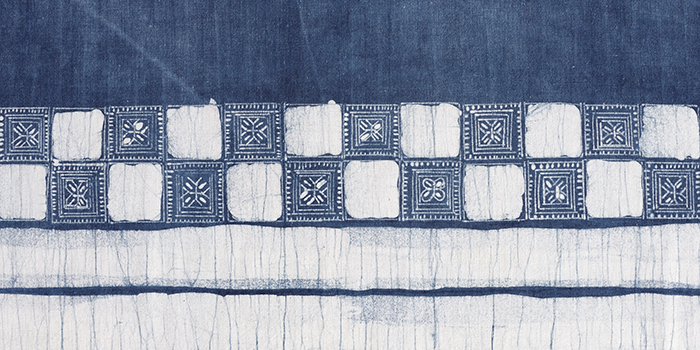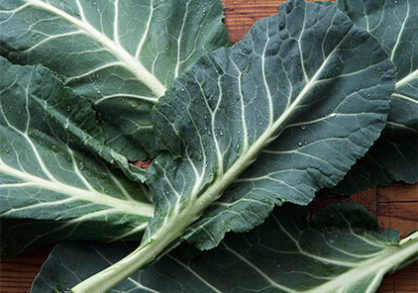
The story of the indigo plant, Indigofera tinctoria, offers one account of the skill and knowledge held by enslaved Africans, who brought to the Americas the rich tradition of indigo dying that developed over centuries in West Africa. On Juneteenth, we honor enslaved Africans and their descendants who carried on their cultural traditions under the duress of being kidnapped and enslaved.
Indigofera tinctoria is the original source of the blue dye known as true indigo. It was a significant cash crop grown on southern plantations by enslaved people who were specifically sought out for their skill and knowledge of planting, cultivating, harvesting, and processing indigo. This popular blue dye was used to color high-quality cloth, primarily sold to upper class Europeans during the 17th and 18th centuries.
The indigo plant is a tropical shrub that typically grows to 2-feet to-3-feet tall and wide. Its native range is likely to be Western tropical Africa, Tanzania to South Africa, along with the Indian Subcontinent to Indo China. Indigo has since become widespread in tropical and subtropical regions around the world.
Indigo dye is obtained by fermenting the leaves, which converts the compound indican into the blue dye indigotin—a laborious process involving collecting leaves that are pounded and formed into balls. Once dried, the balls are mixed with water that has been filtered through ash from burning green wood. After several days of fermentation, the mixture’s strong odor and foaming surface indicates the mixture is ready for dying.

Creating and using blue dye made from indigo leaves has been practiced by West African artisans for centuries. Africans including the Yoruba of Benin, the Manding of Mali, and the Hausa of Kano were renowned for indigo processing and dyeing. Skilled indigo dyers were traditionally African women who were known to enlist guidance from the spirit world by applying specific rituals when starting to process a new pot of dye.
Traditional clothing made with the richly dyed cloth signifies prosperity and social status. Patterns and symbols formed on indigo textiles often incorporate a symbolic language that communicates religious beliefs or announces social facts. For example, a checkerboard pattern on cloth made for a woman’s wrapper is a symbol of fertility, renewal, and life. From the mid-1740s until the Revolutionary War, indigo was a major cash crop in South Carolina. Around that time, Indigo dye was a rare and expensive luxury item imported to Europe from the Middle East. To end their dependency of foreign sources, the British cultivated indigo in India, various Caribbean islands, and the southern United States by relying on slave labor.

Because blue was by far the most popular color in Britain during that time, Indigo was exported to Britain in large quantities, garnering significant wealth for plantation owners, dyers, and cloth manufacturers. South Carolina indigo colored most of British-made blue cloth since that dye was cheaper and considered ‘homegrown’.
Although the development of synthetic dyes in the late 1800s decreased the demand for natural sources of color, Indigofera tinctoria continues to be commercially cultivated as a source for natural dyes around the world today.
The story of indigo is one of many accounts of resilience and achievement shared in the plant exhibition “Seeds of Survival and Celebration: Plants and the Black Experience,” which celebrate the knowledge, skill, and resilience of enslaved Africans and their descendants and how their cultural practices are woven into the rich cultural fabric of America today. Learn more about this exhibit and people who are dedicating their life’s work to preserving the heritage of plants significant to Black culture. One is Colah Tawkin, who visited with students and delivered a lecture in fall of 2023.
Seeds of Survival and Celebration
This garden and exhibit tell stories of the deep connections of the formerly enslaved to plants and illustrate their contributions to the cuisines enjoyed across American society today.
Honoring black culture through plants
Explore the plants included in “Seeds of Survival and Celebration: Plants and the Black Experience.”
Lucky peas for the new year
Eating Hoppin’ John is one of countless traditions across cultures worldwide to bring good luck in the New Year.


